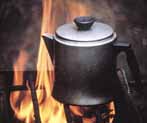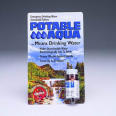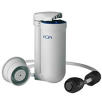
A
Safe Drink Of Water
Water
Treatment In The Backcountry
By: Eric
Osterling
If you don't
treat backcountry water, you're risking spending your
vacation in intestinal distress. It's no longer safe to
drink straight out of alpine rivers and streams. Here's
how to avoid nasty water critters you might encounter
such as Giardia, Lamblia, and Cryptosporidium:

 Boiling:
Boiling:
This is the tried and true method of killing microscopic
beasties, but it takes a lot of fuel. Fires work, but
they're not exactly minimum impact, plus your water ends
up tasting like woodsmoke. If you do use a fire, decant
the water from one bottle to another to get rid of the
sour burnt taste. Or, throw in a couple of herbal tea-bags
or Crystal Light.
There's a lot
of disagreement over just how long you need to boil water
for. Some agencies recommend five minutes or even longer,
especially at higher altitudes. Others say that a strong
rolling boil at any altitude will kill the cooties. The
Centers for Disease Control recommends three minutes to
make sure everything is really and truly dead, including
hardy viruses (more a problem in developing countries
than in the American backcountry).
 Iodine
Tablets & Drops:
Iodine
Tablets & Drops:
Iodine has some compelling advantages: it's lightweight,
reliable, and trouble-free. But it does not kill the most
recent arrival on the microbial scene: Cryptosporidium,
which causes  giardia-like symptoms and has no cure (the disease runs
its course in 7 -10 days). Iodine is available in liquid,
crystals, or tablets. Read the directions for how much
to use and how long to wait - more iodine and longer waiting
times are required in cold or especially dirty water.
To mask the flavor, you can drop in tablets made by Potable
Aqua. Or stick a piece of lemon peel in your water bottle
- it'll freshen several liters. Note: it's not a good
idea to use iodine for days on end, but it is an excellent
idea to carry a few tablets, even if you plan to mostly
filter or boil your water. That way, even if you don't
feel like filtering or boiling (say it's terrible weather
and you're exhausted), you'll still be able to drink.
giardia-like symptoms and has no cure (the disease runs
its course in 7 -10 days). Iodine is available in liquid,
crystals, or tablets. Read the directions for how much
to use and how long to wait - more iodine and longer waiting
times are required in cold or especially dirty water.
To mask the flavor, you can drop in tablets made by Potable
Aqua. Or stick a piece of lemon peel in your water bottle
- it'll freshen several liters. Note: it's not a good
idea to use iodine for days on end, but it is an excellent
idea to carry a few tablets, even if you plan to mostly
filter or boil your water. That way, even if you don't
feel like filtering or boiling (say it's terrible weather
and you're exhausted), you'll still be able to drink.
 Portable
Water Filters:
Portable
Water Filters:
Few pieces of backpacking equipment are as vilified as
water filters. Think of filters as microscopic strainers.
They give you clean water with no bad taste - and no  residue
of fugglies floating in your canteen. To choose a filter,
first look at the"absolute" pore size, which
should be 1 micron or less for hiking in North America:
That'll take care of both Giardia and Cryptosporidium.
For hiking abroad, you may also need a filter that can
handle viruses.
residue
of fugglies floating in your canteen. To choose a filter,
first look at the"absolute" pore size, which
should be 1 micron or less for hiking in North America:
That'll take care of both Giardia and Cryptosporidium.
For hiking abroad, you may also need a filter that can
handle viruses.
*Avoiding Clogging:
Clogging is the main filter problem. You can help prevent
it by keeping the filter element as clean as possible.
Start by using clear water. If that's not an option, let
clouded water sit for a while so that the gunk settles
on the bottom. You can also pre-filter water through a
bandanna or use the prefilter that comes with some filter
systems. If you're filtering directly from the water source,
use a float to keep your intake tube off of the river
or lake bottom.
*Unclogging Your
Filter: Filters clog because they do their job: The
gunk that clogs them is gunk you'd otherwise be drinking.
Make sure you take your filter's directions into the field
with you. Some ceramic filters can be cleaned by scrubbing
the element with an old toothbrush. Others can be wiped
clean. Some filters can be backwashed, which is a temporary
solution. Reverse the intake and output tubes, then pump
backwards so the water flushes the gunk out of the filter
element. After backwashing, you must run clean water that
has been treated with iodine or bleach through the filter
and its hoses.
>>
Rate and Review This Article
 For
more information please refer to the High
Sierra Topix message board.
For
more information please refer to the High
Sierra Topix message board.
